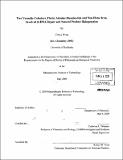| dc.contributor.advisor | Catherine L. Drennan. | en_US |
| dc.contributor.author | Wong, Cintyu | en_US |
| dc.contributor.other | Massachusetts Institute of Technology. Dept. of Chemistry. | en_US |
| dc.date.accessioned | 2009-11-06T16:29:27Z | |
| dc.date.available | 2009-11-06T16:29:27Z | |
| dc.date.copyright | 2009 | en_US |
| dc.date.issued | 2009 | en_US |
| dc.identifier.uri | http://hdl.handle.net/1721.1/49749 | |
| dc.description | Thesis (Ph. D.)--Massachusetts Institute of Technology, Dept. of Chemistry, 2009. | en_US |
| dc.description | Vita. | en_US |
| dc.description | Includes bibliographical references. | en_US |
| dc.description.abstract | Cofactors assist enzymes with a variety of complex chemistries. Two versatile cofactors, flavin adenine dinucleotide (FAD) and non-heme iron, together with molecular oxygen as an oxidizing agent, perform a wide array of reactions. Hydroxylation in DNA repair is one example. AidB is an adaptive response protein that is up-regulated in the presence of alkylating agents. AidB contains FAD; however, the precise role of the FAD has been determined. AlkB, another adaptive response protein that is up-regulated in the presence of alkylating agents, is a member of the alpha-ketoglutarate (aKG) non-heme iron-dependent superfamily. It uses the cofactor non-heme iron, and the co-substrates molecular oxygen a: G, to remove alkylated adducts on DNA bases via hydroxylation. Two well characterized 1 homologues of AlkB, hABH2 and hABH3, also belong to the XKG/Fe(II)-dependent superfamily, but their substrate preference differ from that of AlkB. Furthermore, FAD and non-heme iron, again with molecular oxygen as an oxidizing agent, can perform halogenation chemistry. Flavin-dependent halogenasess perform halogenation reactions on aromatic substrates, while non-heme iron-dependent halogenases perform halogenations reactions on unactivated aliphatic substrates. I is a flavin-dependent halogenase that catalyzes the chlorination of free tryptophan to form 7-chlorotryptophan in the biosynthesis of rebeccamycin. CytC3 is an cxKG and non-heme iron-dependent halogenase that catalyzes the chlorination of L-2-aminobutyric acid bound to thiolation domain in the biosynthesis of yy-dichloroaminobutyrate. | en_US |
| dc.description.abstract | (cont.) Here, we obtained the crystal structures of flavoproten I and non-heme iron-dependent halogenase CytC3. The structural and biochemical v n AidB provides new insights into various possible functions of this still poorly understood protein. The crystal structure of CytC3 suggests two important criteria for creating an enzyme--bound Fe-Cl catalyst. Additionally, we established a new purification scheme for AlkB ts human homologues, which has yielded protein for biochemical studies aimed at ex i ; substrate specificity. Finally, we have also obtained a new crystal form for E. coli AlkB. | en_US |
| dc.description.statementofresponsibility | by Cintyu Wong. | en_US |
| dc.format.extent | 211 p. | en_US |
| dc.language.iso | eng | en_US |
| dc.publisher | Massachusetts Institute of Technology | en_US |
| dc.rights | M.I.T. theses are protected by
copyright. They may be viewed from this source for any purpose, but
reproduction or distribution in any format is prohibited without written
permission. See provided URL for inquiries about permission. | en_US |
| dc.rights.uri | http://dspace.mit.edu/handle/1721.1/7582 | en_US |
| dc.subject | Chemistry. | en_US |
| dc.title | Two versatile cofactors, flavin adenine dinucleotide and non-heme iron, involved in DNA repair and natural product halogenation | en_US |
| dc.title.alternative | 2 versatile cofactors, flavin adenine dinucleotide and non-heme iron, involved in DNA repair and natural product halogenation | en_US |
| dc.type | Thesis | en_US |
| dc.description.degree | Ph.D. | en_US |
| dc.contributor.department | Massachusetts Institute of Technology. Department of Chemistry | |
| dc.identifier.oclc | 456555677 | en_US |
